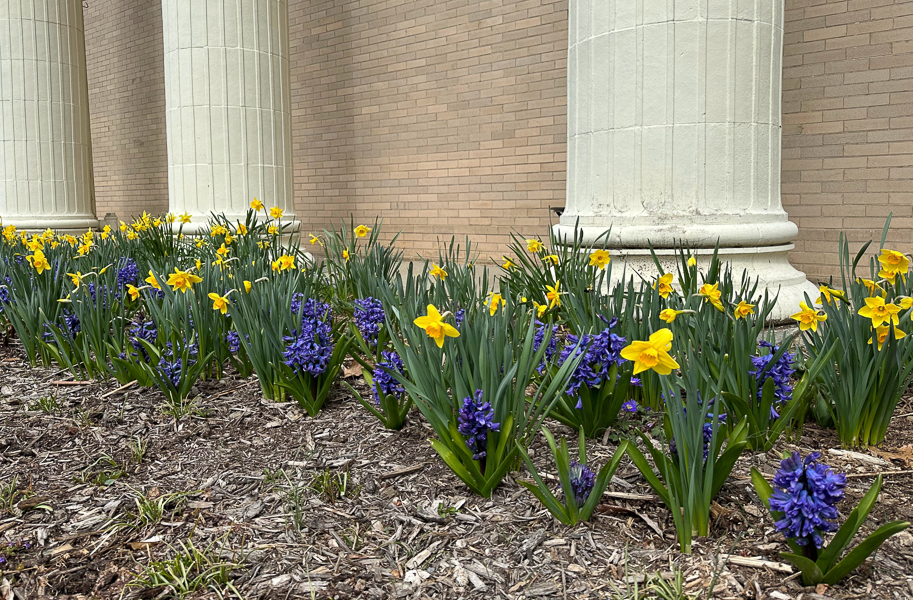by Gretchen Lytle
Introduction
Winters have become milder and a bit shorter in the Hudson Valley. But winter is winter, and we all seem to long for spring’s arrival. Come early March at Bard, we look for signs of spring awakenings by the south sides of buildings, in little protected areas, at low elevations, and down near the river. Those are the warmer spots where buds first blossom. April is here now, and we can see more than little white snowdrops, bright yellow aconite, blue scilla, and purple, white, or yellow crocus close to the ground along the paths and framing the buildings on campus. The taller daffodils have emerged, followed by tulips and hyacinths. Now the shrubs and trees are waking up, budding and flowering, and they are at the mercy of the seasonal weather swings in precipitation and temperature. If the temperature drops precipitously overnight, buds can freeze, blossoms can brown, and fruit growth can be stopped in its tracks. We can only hope for a gentle transition into true spring.




Look for the Yellow
LLI classes are back on campus, in-person. It’s a lovely time of year to stroll the main campus and take in the ever-expanding arboretum. If you have time before class, between classes, or after class, head right outside Olin to enjoy the spring colors. As you step down Olin’s front entry, look across to the back of Hegeman, where you may still see the vibrant yellow blossoms of the Cornus mas (aka Cornelian cherry), which is, in fact, a member of the Dogwood family. It is one of the first to burst. There are other Cornus mas on campus, including one just beyond the northeast corner of the Olin parking lot.
Another source of a strong yellow is forsythia, which can be spotted near the Stevenson Library south side, in front of the President’s house, and scattered in other locations around the campus. Take a walk up Kappa Path from Annandale Road where you will be framed by gorgeous forsythia hedges. If you’re up for a longer walk, look for the white (!) forsythia on the south side of the loop at the Levy/Blithewood. On your return to the center of campus, walk by Tewksbury to catch the weeping cherry, and be sure to go by the grove of crabapples on the southwest side of Bertelsmann.
Serviceberry Blooming
As you walk the campus, you may come across the lovely, little white blossoms of serviceberry, aka shadbush, another early bloomer. Look for it both along the side of the Hessel parking area and the Olin parking lot. Shadbush flowers at the same time that shad, the largest of the herring family, run up the Hudson River in early spring. A traditional early spring meal used to be shad, shad roe, asparagus, and new potatoes. This is also the time when the ground has thawed enough to dig gravesites again, and milder weather allowed circuit preachers to travel to deeper settlements for services again. There is a large serviceberry on the main lawn, just north of the path from RKC heading west to Annandale Road. From there, walk north across the lawn and look for the brilliant red quince blossoms on the north side of the walkway that cuts west by Kline.



Magnificent Magnolias
Magnolias are one of the most primitive flowering plants in evolutionary history, and Bard has an impressive array of these beautiful flowering trees. They are tucked in here and there on the main campus, as well as edging the walkway along Campus Road. All one can see in March are their fuzzy buds. Once they explode in April, they are dazzling. Bard has white, pink, and yellow varieties.
Take a short walk out Olin’s main/south door and look to the far side of Henderson Circle, right there, for the yellow Butterflies magnolia, a great draw for pollinators. Make a loop around the east side of Preston to locate the pair of later blooming, creamy white Sweetbay magnolias. Head west up to the Dick Griffiths/Main Campus Walk to catch sight of the magnolia on the southwest side of Preston as well as another magnolia on the west side of that walk. Down below it, on the big main lawn, you can find another Sweetbay magnolia.
For an early blooming pink magnolia, head back up the Main Campus Walk to Faculty Circle past the President’s forsythia, and turn right down Faculty Circle Road towards Campus Road. At the last house (#10) you’ll come across a spectacular pink magnolia that was happily budding in mid-March. Continue down to the path along Campus Road. Look left for a few other magnolias and then walk right towards Olin for more. There are several yellow magnolias not to be missed over by the Cruger dorms. If you’re over there, you can go to Manor House for the early blooming white Star magnolia. Let’s hope that we don’t get freezing nights that brown the lovely blossoms.
Colorful Trees
For those who are taking classes at the gym or in Bard Hall, make your way to the west entrance to the gym, where you will see the glorious white blossoms (with questionable scent/odor) of two venerable, ornamental Bradford pears against the building. Another grouping of Bradford pears will greet those who park at the Olin lot and walk across Campus Road at the north end.


Red Maples and Redbuds
If you don’t have time or energy for a walk, take a look out your car windows as you arrive on campus and as you depart. Look around and skyward for the red haze of red maple blossoms all around campus. Red maples are among the oldest native trees, and along with the other flowering trees and shrubs, attract pollinators and wildlife. Don’t miss the eye-catching redbud trees just to the north of the main entrance on the east side of Campus Road. Interesting that they are called redbuds when their blossoms are usually a strong pink, not red. There are some lovely white/albino redbuds in that space as well.
Welcome Spring!
This is just the beginning of a beautiful time of year throughout the Bard Arboretum. Each day brings subtle changes as other flowering trees and shrubs open. Keep your eyes peeled for dogwoods with white, pink, or red blossoms as well as flowering cherries, and look for the unusual. As the warmer season and longer days bring more color back into our lives, let us welcome spring.





You must be logged in to post a comment.